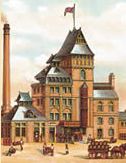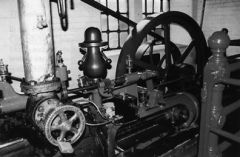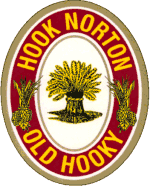 |

|
|

|
|
|
 |

home
about
features
A-Z
books

|

|

Protz:
features
reviews
tastings
|

| |
The beers of Brigadoon - Hook Norton
by Willard Clarke, 10/04
"Welcome to Brigadoon," Stewart Main, the head brewer at Hook Norton said. As a Scot, he is well versed in the story of the mythical Highland village of Brigadoon that appears for a single day once every hundred years and bewitches all who come across it.
The Hook Norton Brewery isn't a dream but you have to pinch yourself to believe it exists. It stands in a small town of the same name, with chunky cottages built of mellow Cotswold stone. Although it's only a few miles from Banbury, Hook Norton is hidden down winding country roads, and suddenly emerges from a dip in the gentle hills. Putting God before Mammon, first the tall and imposing church tower appears above the hedgerows, followed by a second tower that is part of the brewery.
You find, with the help of friendly locals, Brewery Lane and suddenly the full force of this architectural gem is upon you. Hook Norton is a Victorian "tower brewery", standing
six storeys proud, with the brewing process flowing naturally from floor to floor.
It seems remarkable that this imposing stone and wood building should exist in an isolated rural area. But in 1849, with the industrial
revolution going full throttle, brewing was turning from a publican's sideline into a major business that quenched the thirsts of factory and farm workers. |
|
 |
Hook Norton not only had farm labourers in abundance but industry as well: an ironstone quarry produced building materials between 1884 and 1948, and the railway came to the village in 1887, the line dug out of the hills by an army of navvies with an insatiable need for refreshment.
Both quarry and railway have long gone but Hook Norton Brewery no longer relies solely on local trade. As well as 45 tied houses, it has free trade throughout the country, bringing its beautifully made traditional beers to a new and admiring audience.
Hook Norton is a working brewery museum. If you clamber up and down the narrow stairs and walkways in the brewery you will catch not a glimpse but a full and inspiring picture of brewing in the 19th century.
His brother James having died very recently, David Clarke now owns the company, and is at pains to stress he is not running some quaint piece of folklore but a modern business. Nevertheless, Hook Norton stands as a
magnificent piece of history and a brilliant example of craft brewing at a time when so many modern plants are run not by people but by soulless computers.
The brewery's history dates from 1849. John Harris set up in business as a maltster in the village, supplying grain to local pubs where beer was still made on the premises. It's likely that Harris also brewed for his family and farm
workers. In 1856 he installed fermenters and other equipment on the farm and became a serious brewer as well as maltster.
Harris the brewer flourished. By 1872 he had built a three-storey brewery on the farm and when the business passed to his relations, the Clarkes, they commissioned the leading brewery architect of the time, William
Bradford, to construct the present majestic site. Bradford was also responsible for the glories of Harvey's of Lewes, Shipstone's of Nottingham and Tolly Cobbold of Ipswich.
 |
|
Fittingly, the new Hook Norton brewery came into operation in 1900, celebrating the birth of a new century. All the equipment was run by a 25-horse power steam engine built by Buxton & Thornley of Burton-on-Trent for �175.
The engine is still the heart beat of the brewery today, huffing and puffing as it drives the malt mill that grinds the malt, then sends brewing water and grain to mash tuns, coppers and fermenters. |
Some of the original pieces of equipment - a stone malt mill and copper, for example - can still be viewed in the brewery. But many vessels have been replaced over the years. The current mash tun, where the malt is mixed with pure hot water to start the brewing process, came from Ruddles of Rutland. The copper, where the sugary extract is boiled with hops, came from another defunct and famous brewery, Flowers of Cheltenham.
The most astonishing piece of kit lies beneath the brewery roof. It's an open wort cooler or "cool ship" that must surely now be unique in Britain. When the wort is boiled with hops, the liquid has to be cooled before fermentation. With the help of that amazing steam engine, the wort rises to the top of the brewery and settles in the large open pan. Louvred windows allow cool breezes to enter and lower the temperature.
The wort then drops down several storeys into fermenting vessels. They are a joy to behold, circular wooden vessels known as "rounds", the staves held in place by great iron hoops.
Brewing is achingly traditional. Maris Otter, the choicest and juiciest malting variety, is preferred. The hops are whole hops - no pellets or extracts here, if you please. Again, the varieties are sturdily English: Challenger, Fuggles and Goldings. The new "hedgerow" variety, First Gold, which grows to only half the height of conventional hops, is used in some seasonal beers.
Stewart Main, who trained at Heriot Watt in Edinburgh and brewed at Burtonwood before heading south, doesn't stint on his malts, using not only conventional pale and crystal but also amber, chocolate, black and even peated malt from the whisky industry for one seasonal ale. "We're flirtatious with our malts," David Clarke explained.
A splendid new reception area next to the brewery is based in the original maltings. It houses a shop, a small museum dedicated to the brewery and the village, and a bar where visitors can sample regular and seasonal beers.
The first commercial beer produced by John Harris was a mild ale and Mild still features in the Hook Norton portfolio, a 3% dark beer with a fine biscuity aroma and generous hop bitterness for the style.
Stewart Main describes the 3.4% Best Bitter as an "aperitif beer", with a lemon fruit note from the hops and pleasing juicy malt. Generation (4%) uses a chewy amber malt for colour and flavour, and has a spicy, smoky aroma and flavour with rich fruit from First Gold hops.
The legendary Old Hooky (4.6%) has a malty, Ovaltine-like aroma with tangy fruit and spicy hops, while Cooper Ale (4.8%) - copper coloured, with raisin-like fruit and peppery hops - was brewed to celebrate the
brewery's 150th anniversary. The standout beer for me was the 4.8% Double Stout, with a burnt fruit, liquorice, molasses and spicy hops character. |
|
 |
Hook Norton is by birthright and belief a cask beer brewery. Just 2% of production is bottled and the company can proudly claim that is has never produced a keg beer. Horse-drawn drays still deliver casks to local pubs: the
horses are stabled on site.
But to prove that the brewery does move with the times, the pubs are devising menus that link beer with food and one pub has held beer-and-food evenings that have been a considerable success.
But still the time warp persists. Driving back from Hook Norton I went through another lovely old Cotswold village where the off-licence displays a sign advertising Watneys Red Barrel. Then I knew I was dreaming.
Hook Norton brewery and museum are open Monday to Friday plus bank holidays, 9am-5pm. Details: 01608 730384.
|
|
home
about
features
A-Z
books
|

